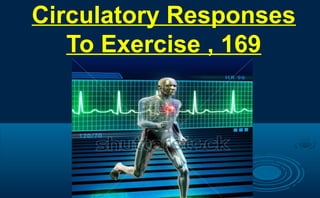
Lec 5a circulati on exercise physiology
- 1. Circulatory Responses To Exercise , 169
- 2. The primary purpose of the cardio respiratory system is to deliver adequate amounts of oxygen and remove wastes from body tissues
- 3. One of the major challenges to homeostasis posed by exercise is the increased muscular demand for oxygen; during heavy exercise the demand may be fifteen to twenty-five times greater than at rest.
- 4. To meet the increased oxygen demands of muscle during exercise, two major adjustments of blood flow must be made : (I) an increased cardiac output (i.e, increased amount of blood pumped per minute by the heart) and (2) a redistribution of blood flow from inactive organs to the active skeletal muscles.
- 5. Organization of The Circulatory System The human circulatory system is a closed loop that circulates blood to all body tissues. Blood travels away from the heart in arteries and returns to the heart by way of veins.
- 6. The system is considered "closed“ because arteries and veins are continuous with each other through smaller vessels
- 7. As the vessels become microscopic they form arterioles, which eventually develop into "beds" of much smaller vessels called capillaries. Capillaries are the smallest and most numerous of blood vessels; all exchanges of oxygen, carbon dioxide, and nutrients between tissues and the circulatory system occur across capillary beds.
- 8. Blood passes from capillary beds to small venous vessels called venules. As venules move back toward the heart. they increase in size and become veins . The mixture of venous blood from both the upper and lower body that accumulates in the right side of the heart is termed mixed venous blood.
- 9. Structure of the Heart The heart is divided into four chambers and is often considered to be two pumps in one . The right atrium and right ventricle form the right pump, and the left atrium and left ventricle combine to make the left pump
- 11. The right side of the heart is separated from the left side by a muscular wall called the inter ventricular septum. This septum prevents the mixing of blood from the two sides of the heart.
- 12. Pulmonary and Systemic Circuits The heart can be considered as two pumps in one. The right side of the heart pumps blood that is partially depleted of its oxygen content and contains an elevated carbon dioxide content as a result of gas exchange in the various tissues of the body. This blood is delivered from the right heart into the lungs through the pulmonary circuit.
- 13. At the lungs, oxygen is loaded into the blood and carbon dioxide is released. This "oxygenated“ blood then travels to the left side of the heart and is pumped to the various tissues of the body via the systemic circuit
- 14. HEART: MYOCARDIUM AND CARDIAC CYCLE Myocardium: The wall of the heart is composed of three layers: (I) An outer layer called the epicardium. (2) A muscular middle layer, the myocardium , and (3) An inner layer known as the endocardium
- 15. It is the myocardium, or heart muscle, that is responsible for contracting and forcing blood out of the heart. The myocardium receives its blood supply via the right and left coronary arteries.
- 16. Maintaining a constant blood supply to the heart via the coronary arteries is critical because, even at rest, the heart has a high demand for oxygen and nutrients.
- 17. When coronary blood now is disrupted (ie., blockage of a coronary blood vessel) for more than several minutes, permanent damage to the heart occurs . This type of injury results in the death of cardiac muscle cells and is commonly called a heart attack or myocardial infarction.
- 18. Heart muscle differs from skeletal muscle in several ways. First, cardiac muscle fibers are shorter than skeletal muscle fibers and are connected in a tight series. Further, cardiac fibers are typically branched ,whereas skeletal muscle fibers are elongated and do not branch . Also, cardiac muscLe contraction is involuntary, whereas skeletal muscle contractions are under voluntary control.
- 19. Heart muscle fibers are highly aerobic and contain large numbers of mitochondria. Note, however, that cardiac muscle fibers contain many more mitochondria than type I, slow skeletal muscle fibers. This fact highlights the importance of continuous aerobic metabolism in the heart
- 20. Blood pressure can be increased by one or all of the following factors : A. Increase in blood volume, B. Increase in heart rate, C. Increased blood viscosity, D increase in stroke volume, and/or E. Increased peripheral resistance.
- 26. CARDIAC OUTPUT Cardiac output (0) is the product of the heart rate (HR) and the stroke volume (SV) (amount of blood pumped per heartbeat) (} =HR x SV Thus, cardiac output can be increased due to a rise in either heart rate or stroke volume
- 27. Approximately 0.1 second after the atrial contraction, the ventricles contract and deliver blood into both the systemic and pulmonary circuits.
- 28. CARDIAC CYCLE The cardiac cycle refers to the repeating pattern of contraction and relaxation of the heart. The contraction phase is called systole and the relaxation period is called diastole.
- 42. THANKSTHANKS